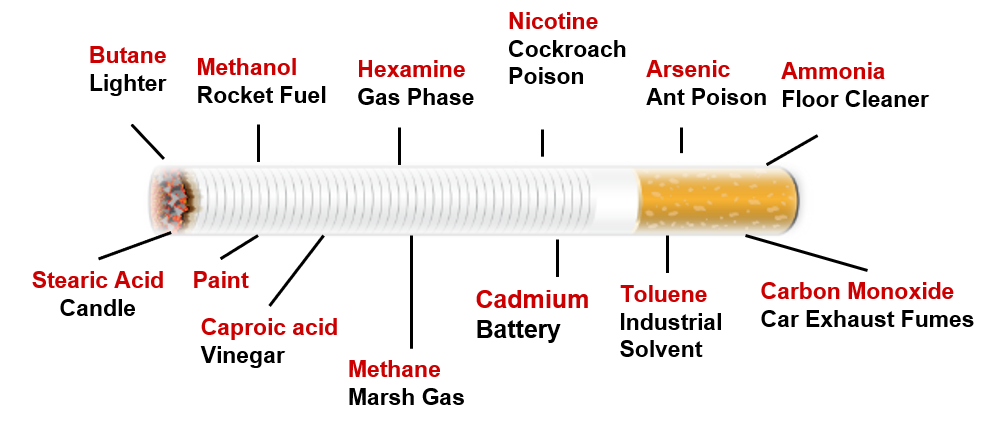Active Smoking
|
A number of medical researches show that One in every two smokers will die early from smoking. |
Harmful substances in tobacco
- Tobacco contains more than 7,000 chemicals, most of them are toxic and radioactive including over 70 carcinogens.

- Three major killers in tobacco are tar, nicotine and carbon monoxide. They are colourless and odorless, but harmful to health.
| Tar | Nicotine | Carbon Monoxide |
|
|
|
Diseases caused by smoking
Smoking is hazardous to health. Six of the world’s eight leading causes of death are caused by tobacco use, which include heart diseases, cerebrovascular diseases, lower respiratory infections, chronic obstructive pulmonary diseases, tuberculosis and cancers of trachea, bronchus and lung.

Cancers
- Smoking is responsible for many types of deadly cancers, including cancers of mouth and throat, lung cancer, oesophageal cancer, bladder and kidney cancer, pancreatic cancer, stomach cancer, liver cancer, cervical cancer and leukaemia.
- A smoker increases the risk of getting lung cancer by 900 percent (10 times), and a heavy smoker increases the risk over 1400 percent (15-25 times the risk).
Cardiac diseases
- Nicotine in tobacco affects the nervous system, increases the heart rate and narrows the blood vessels which can elevate blood pressure.
- The carbon monoxide in cigarettes depletes the oxygen carrying capacity of a smoker’s blood. The heart has to pump harder to get enough oxygen to the rest of the body.
- Smoking also raises the cholesterol and fibrinogen levels in blood and increases the risk of myocardial infarction and heart attack caused by blood clotting.
- Other cardiac diseases related to smoking include coronary heart disease, aneurysm, peripheral vascular disease, stroke and etc.
Respiratory diseases
- Smoking causes the accumulation of harmful substances inside the bronchial tubes. The obstruction of small airways in the lung will lead to rupture of the air sacs, causing emphysema.
- Another common smoking related disease is chronic bronchitis, which has similar symptoms as emphysema.
Genital diseases
- Cigarette smoking can affect fertility, sexual function and the health of pregnant women, fetuses and young children.
Fertility
- Smokers may have reduced fertility. Studies found that 38% of non-smokers conceived in their first cycle compared with 28% of smokers. Smokers were 3.4 times more likely than non-smokers to have taken more than one year to conceive.
- Research estimated that the fertility of smoking women was 28% lower than of non-smokers.
- Cigarette smoking can also affect male-fertility; spermatozoa from smokers are found to be decreased in density and motility compared with that of non-smokers.
Sexual function
- Smoking may cause impotence, or penile erection dysfunction in the male smokers.
- Studies suggest that the risk of impotence for smoking men aged 31-49 years old was 1.5 times higher than non-smokers. Smoking men aged 40-70 years old are twice as likely as non-smokers to develop moderate or severe impotence.
Health of pregnant women
- Babies born to women who smoke are on average 200 grams (8 ozs) lighter than babies born to comparable non-smoking mothers. Low birth weight is associated with higher risks of death and diseases in infancy and early childhood.
- Recent research suggests that cigarettes can reduce the flow of blood in the placenta which limits the amount of nutrients that reach the foetus.
- The rate of spontaneous abortion (miscarrage) is substantially increased in women who smoke by tenfold.
- Moreover, smokers have more complications of pregnancy and labour which include bleeding during pregnancy, premature detachments of the placenta and premature rupture of the membranes, and inadequate milk production.
Health of fetuses and young children
- Perinatal mortality is increased by about one-third in babies of smokers.
- Infants of parents who smoke are twice as likely to suffer from serious respiratory infection than the children of nonsmokers.
- Smoking during pregnancy can also increase the risk of asthma in young children (before 1-year-old) by 2.8 times.
- Smoking in pregnancy also have implications for the long term physical growth and intellectual development of the child, such as reduced height, lower attainments in reading and mathematics.
Other health hazards
Eyes
- Chemicals in tobacco cause damage to the macula. Tiny blood vessels can burst through the macula, leading to irreversible damage.
Accelerate aging, damage to skin and hair’s health
- The natural menopause occurs up to two years earlier in smokers. Those smoking more than ten cigarettes a day having an increased risk of an early menopause.
- Decrease oxygen supply to body and skin. Accelerate aging.
- Rob the skin of collagen which keeps the skin elastic.
- Smokers get more and deeper wrinkles all over their faces because nicotine constricts the tiny capillaries that nourish the skin. Smokers in their 40s often have as many facial wrinkles as non-smokers in their 60s.
- Smokers are also prone to premature thinning and graying of the hair. Men who smoke are twice as likely to become bald as are men who do not smoke, and premature graying is 3 to 6 times more common in smokers.
Muscles and Bones
- Smoking delays the healing of fractures, and in some smokers’ bone healing is indefinitely delayed.
- Women with a smoking history have significantly lower bone density and are much more likely to suffer from fractures. Furthermore, their earlier menopause increases the risk of osteoporosis.
- Smokers also have poorer muscle strength, agility and balance.
